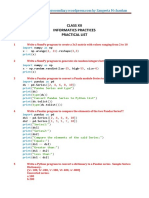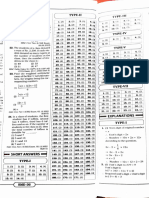Intro to Programming with Python - Final exam Practice Fall 2024
Uploaded by
Thanh DoãnIntro to Programming with Python - Final exam Practice Fall 2024
Uploaded by
Thanh DoãnFinal Exam - Fall 2024
BANA3020 Introduction to Programming with Python January 08, 2025
(Practice)
Test duration: 120 minutes
Exam Submission Instructions:
• Academic honesty is required in all work you submit to be graded. You should NOT copy
or share your code with other students to avoid plagiarism issues.
• You must stop working on the exam and submit your solutions on time. Otherwise, your
test will NOT be graded.
• This is a open-book exam, and NO Internet access is allowed.
• Drafting paper and pen/pencil are allowed. We will provide the drafting paper to you. DO
NOT USE any web-based drafting/drawing tools during the exam.
• Late submissions without an approved extension will not graded at all.
• During the exam, you are NOT allowed to leave the room or/and use the bathroom. In
case of emergency, you are allowed to leave the exam room maximum of 5 minutes with
the monitoring of an invigilator. Also, you are required to hand over your phone to the
invigilator.
• You will submit your submission to Canvas( Assignment, Final exam) with the following
filename format: Final_P1.py. Your submission MUST have a py extension.
• Good luck!
Final Exam (Theory Part) - Fall 2024 Page 1
Problem 1 (20pts) - Python dictionary, list, and dataframes
You are given a list of students and their grades in multiple subjects. Write a function to_pandas(students)
that takes in a list of students with their grades and returns a Pandas dataframe containing the
students’ grades and the average grade of each student, each rounded to 1 decimal place:
round(avg_grade, 1). Assume that there are only 2 subjects: math and history.
1. students is a list of dictionaries, where each dictionary represents a student and their
grades in math and history. The dictionary has 2 keys: "name" and "grades".
2. "name": a string represent the name of the student.
3. "grades": a dictionary representing the grades of the students in each subject (math and
history). The keys of this dictionary are the names of the subject. The values are the
grades of that student in each subject.
Example case:
>>> students = [{"name": "Alice", "grades": {"math": 90, "history": 85}},
{"name": "Bob", "grades": {"math": 75, "history": 80}},
{"name": "Eve", "grades": {"math": 82, "history": 90}}]
>>> grade_df=average_grades(students))
>>> grade_df
1 Name math history Average
2 0 Alice 90 85 87.5
3 1 Bob 75 80 77.5
4 2 Eve 82 90 86.0
Extra credit (10pts): Your function should work for input of any length. For example, it can
take input like this:
You can see that Eve does not have a grade for English. So in the output data frame, Eve’s
score for English will be 0.
>>> students = [
{"name": "Alice", "grades": {"math": 90, "history": 85, "english":85}},
{"name": "Bob", "grades": {"math": 75, "history": 80, "english": 90}},
{"name": "Eve", "grades": {"math": 82, "history": 90}}]
>>> grade_df=average_grades(students))
>>> grade_df
1 Name math history english Average
2 0 Alice 90 85 85 86.666667
3 1 Bob 75 80 90 81.666667
Final Exam (Theory Part) - Fall 2024 Page 2
4 2 Eve 82 90 0 57.333333
Problem 2 (30pts) - Recursion
Part A - Power (15pts)
Write a function recursion_power(a, b) that compute the value of "a" raised to the power of "b"
using recursion, i.e: ab .
1 print ( recur_power (3 ,4) )
2 81
Part B - Harmonic sum series (15pts)
A harmonic sum series is defined as the sum of reciprocals of positive integers.
1 1 1
H_n = 1 + + + ··· + .
2 3 n
Write a function recursion_hamonic(n) that takes a parameter n and return the harmonic sum
series of n using recursion.
1 print ( re cur si on _ha rm on ic (5) )
2 2.28333333333 3333
Problem 3 (20pts) - OOP
In this problem, you are going to create a Python class named ApartRental. This class models
an apartment rental service with the following service:
1. A __init__(self, location, f loor, bedroom, rate) method that initializes the instance with
key attributes: location of the apartment, which floor it is on (4th floor, for instance), number
of bed rooms, and daily rental rate.
2. A calculate_cost(self, days) method for calculating the total rental cost based on the num-
ber of days the apartment is rented, with a price structure:
• Up to 3 days: Standard daily rate.
• More than 3 and up to 7 days: 15% discount on the total cost.
• More than 7 and up to 14 days: 20 % discount on the total cost.
• More than 14 and above: 25% discount on the total cost.
Final Exam (Theory Part) - Fall 2024 Page 3
3. A __str__ method that returns a string representation of the apartment, including its loca-
tion, floor, number of bedrooms, and daily rental rate: "location,floor, bedroom,rate"
Example:
1 my_apt = ApartRental ( " Vin Ocean " ,4 ,2 ,20)
2 rental_days =3
3 print ( my_apt )
4 Vin Ocean ; 4 floor ; 2 bedrooms ; $60
Problem 4 (30pts) - Sparse matrix again
A sparse matrix is a matrix where most of the elements in the matrix are zeros. A sparse
representation is very convenient for problems that require heavy computation. However, at
the end of the day, you have to reconstruct the matrix from it’s sparse represetation. In this
problem, you will create a function sparse_construct(v,r,c) that returns a matrix A which can be
represented by (v,r,c) which are:
• A vector v that stores all the non-zero elements of the matrix.
• A vector r which has the same length as vector v. Vector r stores the row index of the
corresponding value in vector v.
• A vector c which has the same length as vector v. Vector c stores the column index of the
corresponding value in vector v.
Hint: Numpy will be very helpful. As a matter of fact, (v,r,c) are Numpy arrays. For instance, an
input matrix A will be returned if you make a call sparse_construct(v,r,c) :
0 1 0 1 0 1
A= −1 0 0 v = −1 r = 1 c = 0
0 0 5 5 2 2
Final Exam (Theory Part) - Fall 2024 Page 4
You might also like
- 4.7.3 Practice - Exponential and Logarithmic Functions (Practice) - 2No ratings yet4.7.3 Practice - Exponential and Logarithmic Functions (Practice) - 27 pages
- COSC2429 - Intro To Programming Assessment 2 - Sem A 2021: RMIT Classification: Trusted100% (1)COSC2429 - Intro To Programming Assessment 2 - Sem A 2021: RMIT Classification: Trusted3 pages
- University of Toronto Winter 2011 Midterm: Total: / 45No ratings yetUniversity of Toronto Winter 2011 Midterm: Total: / 458 pages
- Q1: Conference Reviewing (20 PTS, 5 Pts Each) : M M M (I) (J) I J J I M (I) (J) - 1No ratings yetQ1: Conference Reviewing (20 PTS, 5 Pts Each) : M M M (I) (J) I J J I M (I) (J) - 19 pages
- ECE 102 Quiz #2 (W2021) : Your Name (Type Into Box)No ratings yetECE 102 Quiz #2 (W2021) : Your Name (Type Into Box)4 pages
- Assignments 3 String List Dictionary Functions Recursion Python Programming Bcc402No ratings yetAssignments 3 String List Dictionary Functions Recursion Python Programming Bcc4029 pages
- What Will Be The Output For The Following CodeNo ratings yetWhat Will Be The Output For The Following Code19 pages
- Intro to Programming with Python - Midterm ProgrammingNo ratings yetIntro to Programming with Python - Midterm Programming5 pages
- Final - AISSCE 2023 Class 12 A CS Journal QuestionsNo ratings yetFinal - AISSCE 2023 Class 12 A CS Journal Questions33 pages
- Lavender Buildings Social Media Report (3)No ratings yetLavender Buildings Social Media Report (3)44 pages
- Computer Science Xi Paper PT-1 Hy PT-2 SeeNo ratings yetComputer Science Xi Paper PT-1 Hy PT-2 See14 pages
- Final Review Worksheet: CMSC 201 Spring 2019 NameNo ratings yetFinal Review Worksheet: CMSC 201 Spring 2019 Name5 pages
- 42341102_BScMathSc_ProblemSolvingUsingComputers_So_241028_164636No ratings yet42341102_BScMathSc_ProblemSolvingUsingComputers_So_241028_1646367 pages
- Algorithmic Trading & Quantitative Strategies Gappy Lecture 2No ratings yetAlgorithmic Trading & Quantitative Strategies Gappy Lecture 225 pages
- Page 1 of 8 Stage 1 Mathematics Task Ref: A206746 (Revised January 2013) © SACE Board of South Australia 2012No ratings yetPage 1 of 8 Stage 1 Mathematics Task Ref: A206746 (Revised January 2013) © SACE Board of South Australia 20128 pages
- GMAT Math Prep Course 2024 Edition Kolby - Download the ebook now to never miss important information100% (1)GMAT Math Prep Course 2024 Edition Kolby - Download the ebook now to never miss important information57 pages
- Model Building and Simulation of Thermoelectric Module Using Matlab-Simulink100% (1)Model Building and Simulation of Thermoelectric Module Using Matlab-Simulink7 pages
- System of Units:-: Physical Quantity Symbol Dimension Measurement Unit UnitNo ratings yetSystem of Units:-: Physical Quantity Symbol Dimension Measurement Unit Unit5 pages
- (MAA 3.7) TRIGONOMETRIC FUNCTIONS - EcoNo ratings yet(MAA 3.7) TRIGONOMETRIC FUNCTIONS - Eco19 pages
- Boosting The RSI With Modified Inverse Fisher Transform MIFT Part 1No ratings yetBoosting The RSI With Modified Inverse Fisher Transform MIFT Part 17 pages

























































































